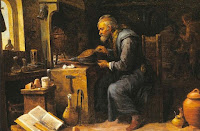Science Demonstrates Mystic Teaching
 |
| AI Generated Free Photo. |
Scientific experiments now exist that provide physical evidence of the behaviors described in ancient mystic teachings. The Double Slit Experiment has been performed since 1801 demonstrating that a photon's character, within a physical system, can be a particle or wave, or both.1 It has also been found that the position and action of subatomic particles are largely conditioned or determined by the expectations of the observer. The very act of observation manifests as a physical change to an object! These changes become more dramatic the closer the particles is to pure energy which could imply that it is closer to thought itself.
This echoes the Hindu teaching that “one creates their own reality”.2 Arguably, there is a significant difference between manifesting a change of character of a subatomic particle versus creating a gold bar from a bar of lead but fundamentally lead and gold are both composed from an accumulation of many sub atomic particles. At the sub atomic level, the only difference between mercury and gold is the addition of 3 elementary particles. This marginal difference was demonstrated as early as 1924 when science literally turned mercury into gold by eliminating these particles.3
Another ancient core postulate is the direct connection between all living beings especially the relation of consciousness among sentient beings.4 In Ricard Bucke's 1901 publication of “A Study in the Evolution of the Human Mind”, he refers to the cosmic consciousness as an emerging faculty and the next stage of human development.5 This zeitgeist or cosmic consciousness is demonstrated within quantum field theories.
Quantum entanglement is the new name for an old gnosis.
Einstein, Podolsky, and Ronsen postulate in 1935 the existence of a “spooky action at a distance” based on the Copenhagen interpretation of quantum mechanics. Their intent was to exemplify that this action, now called quantum entanglement, was proof that the quantum theory was incomplete.6 A basic description of entanglement is that two particles can be created in a manor that each share an indefinite state until measured. Both particles are in some way connected such that any measured attribute of one is instantaneously imposed upon the other regardless of the distance between them. This spooky behavior was indeed proven to exist in 1972 by Freedman and Clauser.7 More recent experimentation has yielded entanglement in larger structures such as buckyballs8 and even small diamonds9.
Even thought has been demonstrated to influence matter by Massaru Emoto in his experiments with water. In these experiments, a person’s projected intentions have demonstrated effects on the molecular structure of water. In these demonstrations, twice distilled water was exposed to both positive and negative prayers, thoughts, and words. After many days of exposure, samples from the water were then frozen and photographed. The crystal’s structures formed from the water exposed to positive influences consistently exhibited superior formations compared to the baseline samples. Conversely there was a retardation of crystallization in the water exposed to negative influences.10 If the mind can influence the atomic structure of water and the human body contains nearly 90 percent water then the teachers of old have had considerable bases for their instruction regarding your thought influences human bodies.
______________________________
1 Young, Thomas Philosophical Transactions of the Royal Society of London: Vol. 94 (1804)
2 Bhagavada Gita: 6.5-6
3 Nagaoka, Hantaro Naturwiss. 13: 682-684 (1925); Journal de Physique et la Radium 6: 209 (1925)
4 Katha Upanishad 1.3.1
5 Bucke, Richard M. Cosmic Consciousness, pp. 19-82, Cosimo Inc., 2007
6 Einstein A, Podolsky B, Rosen N (1935). Can Quantum-Mechanical Description of Physical Reality Be Considered Complete?: Phys. Rev. 47 (10): 777–780
7 Freedman, Stuart J.; Clauser, John F. (1972). Experimental Test of Local Hidden-Variable Theories: Physical Review Letters 28 (14): 938–941
8 Olaf Nairz, Markus Arndt, and Anton Zeilinger, Quantum interference experiments with large molecules: American Journal of Physics, 71 (April 2003) 319-325
9 K. C. Lee, M. R. Sprague, B. J. Sussman, J. Nunn, N. K. Langford, X.-M. Jin, T. Champion, P. Michelberger, K. F. Reim, D. England, D. Jaksch, I. A. Walmsley (2 December 2011). Entangling macroscopic diamonds at room temperature: Science 334 (6060): 1253–1256
10 Emoto, Masaru Messages from Water: Vol. 1 (June 1999)
First © March 29, 2013
<< < | Lecture | > >> |





Comments
Post a Comment